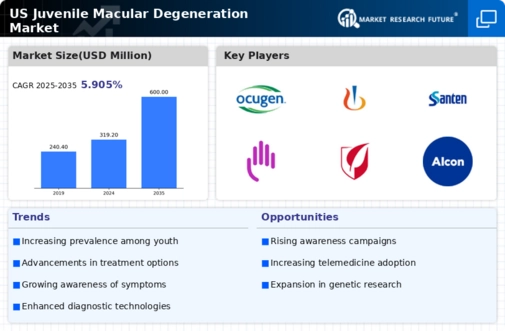Growing Demand for Personalized Medicine
The shift towards personalized medicine is transforming the juvenile macular-degeneration market. Tailoring treatments to the genetic and phenotypic characteristics of individual patients is becoming increasingly feasible, thanks to advancements in genomics and biotechnology. This trend is particularly relevant in the context of juvenile macular degeneration, where genetic factors play a crucial role in disease manifestation. The market is likely to see a rise in demand for personalized therapies that address the unique needs of young patients. As healthcare providers adopt more individualized treatment approaches, the juvenile macular-degeneration market may experience enhanced patient satisfaction and improved clinical outcomes.
Technological Innovations in Diagnostic Tools
Technological advancements in diagnostic tools are significantly impacting the juvenile macular-degeneration market. Innovations such as optical coherence tomography (OCT) and fundus photography have enhanced the ability to detect and monitor the progression of the disease. These tools allow for earlier diagnosis and more accurate assessments of retinal health, which is crucial for effective treatment planning. The market for these diagnostic technologies is projected to grow, with estimates indicating a compound annual growth rate (CAGR) of around 8% over the next five years. As healthcare providers increasingly adopt these advanced diagnostic methods, the juvenile macular-degeneration market is likely to see a corresponding rise in demand for therapeutic interventions.
Increased Investment in Research and Development
Investment in research and development (R&D) is a key driver of the juvenile macular-degeneration market. Pharmaceutical companies and research institutions are allocating substantial resources to explore novel treatment options, including gene therapy and stem cell research. This focus on R&D is expected to yield innovative therapies that could transform the management of juvenile macular degeneration. In the US, funding for ocular research has seen a notable increase, with federal and private sources contributing millions of dollars annually. As new therapies emerge from this investment, the juvenile macular-degeneration market is poised for significant growth, potentially improving outcomes for affected individuals.
Rising Incidence of Juvenile Macular Degeneration
The juvenile macular-degeneration market is experiencing growth due to an increasing incidence of the condition among children and adolescents. Recent studies indicate that the prevalence of juvenile macular degeneration in the US is on the rise, with estimates suggesting that approximately 1 in 10,000 children may be affected. This growing patient population necessitates the development of targeted therapies and interventions, thereby driving market expansion. As healthcare providers become more aware of the condition, the demand for specialized treatments is likely to increase. Furthermore, The juvenile macular-degeneration market is expected to benefit from advancements in genetic research. These advancements may lead to more effective treatment options tailored to the specific needs of younger patients.
Strengthening Regulatory Frameworks for Pediatric Treatments
The evolving regulatory landscape for pediatric treatments is positively impacting the juvenile macular-degeneration market. Regulatory agencies in the US are increasingly recognizing the need for specific guidelines and incentives for developing therapies aimed at children. This shift is likely to encourage pharmaceutical companies to invest in pediatric research and expedite the approval process for juvenile macular degeneration treatments. As a result, the market may witness a surge in the availability of safe and effective therapies tailored for younger populations. Enhanced regulatory support could ultimately lead to improved access to treatment options for children suffering from this condition.
























Leave a Comment